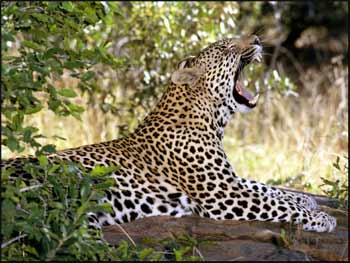
Some pieces of leopard information make more sense when given in relation to something else. For instance the fact that an adult male leopard weighs 60-73kg (132-160 lbs) is interesting but makes more sense when you know that they are much smaller than lion and less than a third the weight of a male tiger.
Their size puts them at a disadvantage when confronted with the bigger predators. Although the leopard ranks above the slender cheetah in the food chain, it lies (in Africa) below the lion, spotted hyena and brown hyena and these will easily rob it of its prey.
That is the main reason a leopard will carry or drag its prey – weighing up to 70kg (150 pounds) or even 100kg (220 pounds) - up a tree to eat it there in peace.
Leopards are nocturnal and hunt at night time, however this piece of leopard information is deceiving because we have seen them hunting during the day (albeit an opportunistic and later abandoned hunt but nevertheless!). Usual behaviour at daytime is to rest in a tree or rock cove and as this cat is a master of camouflage it's very difficult to spot in its natural habitat.
They are solitary so if you’re lucky enough to see more than one, chances are it’ll be a mother and her cubs or a male and female mating.
The male leopard usually disappears after mating so the female raises her 2-3 cubs alone. Humans: do not follow this bad example.
Because they don't have the pride structure like lions do and the consequent safety in numbers to protect and help them, leopard have to be very careful not to get injured during a hunt. An injury or broken limb could spell hunger and starvation for this majestic cat.
Leopards are not fussy eaters and are very opportunistic. They will eat anything from mice, reptiles, fish and birds to adult wildebeest, even small giraffe or adult kudu if they can get it. They are experts at spotting (no pun intended) weak animals.
A leopard prefers to hunt with the least possible energy. I’ve heard stories of them even scavenging young chicks from a vulture nest… who could say no to such an easy meal!
If nothing is available to scavenge, the leopard will either stalk its prey on the ground and wait untill it’s really close before pouncing on it, or ambush from an overhanging branch of a tree.
A tragic example of their opportunistic nature and excellent camouflage is of a leopard in the Kruger National Park (South Africa) which attacked and killed an unsuspecting game warden who was seeking a few minutes rest under a shady tree while out on a game walk.
Their camouflage, soft padded feet, sharp claws and intelligence all contribute to its survival in a wide range of habitat. Today it is probably the only big cat that is still found outside major game and nature reserves. They often leave their tracks on farms and even the outskirts of cities.
Interesting Leopard Information
When the boss says jump, a leopard says “I can do about 2 metres (6.5’) from a still-standing position if I’m motivated. How ‘bout you?”
The appearance of a leopard’s coat varies dependent on region and habitat. Sometimes the "spots" or rosettes are closer together and the background colour also varies from yellow or gold to a reddish brown. The rosette patterns are unique on every leopard but it's easier to identify individuals by the upper row of dots on the face that are associated with their whiskers.
Nature can be cruel sometimes if we look at it from a human point of view. Should a leopard cub die, it will usually be eaten by its own mother.

